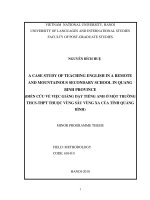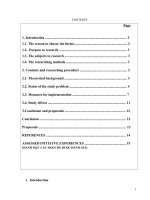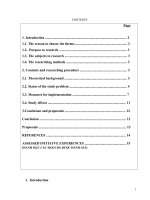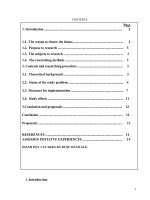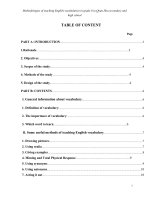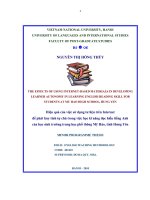Eleventh-graders’ perspectives towards their actual acquisition of writing English skills. a case study at a Pham Ngu Lao high school, Hung Yen
Bạn đang xem bản rút gọn của tài liệu. Xem và tải ngay bản đầy đủ của tài liệu tại đây (15.58 MB, 9 trang )
Vol 8. No 4_October 2022
TẠP CHÍ
ISSN: 2354 - 1431
/>
SCIENTIFIC JOURNAL OF TAN TRAO UNIVERSITY
TẠP CHÍ KHOA HỌC ĐẠI HỌC TÂN TRÀO
TẠP CHÍ KHOA HỌC ĐẠI HỌC TÂN TRÀO
KHOA HỌC GIÁO DỤC
SCIENTIFIC EDUCATION
Tập 8, Số 4 - 10/2022
ISSN: 2354 - 1431
Tập 8, Số 4 (Tháng 10/2022)
Volume 8, Issue 4 (October 2022)
ELEVENTH-GRADERS’ PERSPECTIVES TOWARDS THEIR ACTUAL
ACQUISITION OF WRITING ENGLISH SKILLS. A CASE STUDY AT
A PHAM NGU LAO HIGH SCHOOL, HUNG YEN
Do Thi Vu Phuong
Pham Ngu Lao High School, Viet Nam
Email address:
DOI: />
Article info
Received:05/08/2022
Revised:30/08/2022
Accepted: 25/10/2022
Keywords:
perspectives, negligence,
learner
autonomy,
pedagogical
practices,
testing, and assessment
26|
Abstract:
This study investigated eleventh graders’ viewpoints on the practice of
teaching writing English skills at their schools. A quantitative, descriptive
method was conducted with the participation of 57 eleventh-graders at a
high school in Hung Yen province during the second term of the academic
year 2021-2022. The descriptive survey adapted partially to Marquette
University’s (2008) questionnaire was floated in the participants to examine
their perspectives on General English Writing Skills; Grammar, Punctuation,
and Mechanics Skills; and Grammar, Punctuation, and Mechanics Strategies.
The results reveal that high school students are not good at writing English
paragraphs due to the negligence of the testing and assessment format, which
concentrates on multiple-choice tests. Besides, learner autonomy in improving
writing skills is demotivated and discouraged to develop English paragraph
writing. The finding of this research would help the educational policy-makers
adjust the English teaching curriculum to give a priority to promoting writing
skills. Simultaneously, teachers of English should change their pedagogical
practices to raise their learners’ awareness of the key role of writing English
skills. English language learners, could recognize the importance of writing
effectively in English. Lastly, future studies might consult the findings of this
research for the reference to serving as the resourceful enrichment of their
research liability.
Vol 8. No 4_October 2022
TẠP CHÍ
ISSN: 2354 - 1431
/>
TẠP CHÍ KHOA HỌC ĐẠI HỌC TÂN TRÀO
TẠP CHÍ KHOA HỌC ĐẠI HỌC TÂN TRÀO
SCIENTIFIC JOURNAL OF TAN TRAO UNIVERSITY
KHOA HỌC GIÁO DỤC
SCIENTIFIC EDUCATION
Tập 8, Số 4 - 10/2022
ISSN: 2354 - 1431
Tập 8, Số 4 (Tháng 10/2022)
Volume 8, Issue 4 (October 2022)
QUAN ĐIỂM CỦA HỌC SINH LỚP 11 VỀ VIỆC HỌC KỸ NĂNG VIẾT
NGHIÊN CỨU ĐIÊN HÌNH TẠI TRƯỜNG TRUNG HỌC PHỔ THÔNG PHẠM NGŨ LÃO,
TỈNH HƯNG YÊN
Đỗ Thị Vũ Phương
Trường THPT Phạm Ngũ Lão, Hưng Yên,Việt Nam
Địa chỉ email:
DOI: />
Thông tin bài viết
Ngày nhận bài: 05/08/2022
Ngày sửa bài: 30/08/2022
Ngày duyệt đăng:25/10/2022
Từ khóa:
quan điểm; sự khơng quan
tâm; tính tự chủ; thực tiễn sư
phạm; kiểm tra, đánh giá
Tóm tắt
Nghiên cứu này đã khảo sát quan điểm của học sinh lớp 11 về việc thực
hành dạy kỹ năng viết tiếng Anh tại trường. Phương pháp mô tả, định lượng
được tiến hành với sự tham gia của 57 học sinh lớp 11 tại trường trung học
phổ thông trên địa bàn tỉnh Hưng Yên trong học kỳ 2 năm học 2021-2022.
Khảo sát mô tả được sử dụng một phần bảng câu hỏi của Đại học Marquette
(2008) đã được sử dụng để khảo sát người tham gia, xem xét quan điểm của
người học đối với kỹ năng Viết tiếng Anh tổng quát; Kỹ năng Ngữ pháp,
dấu câu và hành văn, và chiến lược cách sử dụng Ngữ pháp, dấu câu và hành
văn. Kết quả cho thấy học sinh trung học phổ thông viết đoạn văn tiếng Anh
chưa tốt do hình thức kiểm tra, đánh giá mơn tiếng Anh chỉ tập trung vào
các bài thi trắc nghiệm, khơng có tự luận. Bên cạnh đó, sự tự chủ của người
học trong việc cải thiện kỹ năng viết tiếng Anh khơng được khuyến khích,
phát triển. Phát hiện của nghiên cứu này sẽ giúp các nhà hoạch định chính
sách giáo dục điều chỉnh chương trình giảng dạy tiếng Anh để ưu tiên thúc
đẩy kỹ năng viết. Đồng thời, giáo viên dạy tiếng Anh nên thay đổi phương
pháp sư phạm để nâng cao nhận thức của người học về vai trò quan trọng
của kỹ năng viết tiếng Anh. Đối với những người học tiếng Anh, họ có thể
nhận ra tầm quan trọng của kỹ năng viết tiếng Anh hiệu quả. Cuối cùng, các
nghiên cứu trong tương lai có thể tham khảo các phát hiện của nghiên cứu
này nhằm nâng cao độ tin cậy cho những nghiên cứu của họ.
Introduction
English language teaching and learning (ELT)
basically develops four fundamental micro-language
skills, namely reading, writing, listening, and speaking.
In fact, methodological approaches have been reshaped
and reformed continuously with the aim to gain the
most fruitful teaching and learning outcomes [1].
In addition, the role of teachers in class sessions
has been shifted from teacher-centered teaching to
learner-centered approach, which focuses more on
the learners’ academic achievements [2]. Therefore,
teachers’ pedagogical practices have to be renovated
to meet challenges and requirements of current ELT
expectations. It can be said that teaching is an art, not
science [3]. As such, language learners are unavoidable
when language learners try to acquire not only a second
language (L2) but also their mother tongue (L1). Writing
|27
Do Thi Vu Phuong/Vol 8. No 4_October 2022| p.26-34
and speaking are classified as the productive skills
referring to the production of words, phrases, sentences
and paragraphs. It is, evidently, undeniable that writing
plays an important role in ELT among four basic microskills in learning English as a foreign language (EFL).
It is also considered as one of the most challenging
and difficult skills to be developed as the ability to
produce good writing pieces does not come from the
inborn aptitude or innate skills, which has to be learnt
and experienced by intensive teaching and learning
practices [4]. Basically, writing comprises accurate and
meaningful components intertwined to yield a wellwritten output, requiring a developed scheme for word
choice to represent the writer’s communicative ideas
coherently and clearly [5]. The principal objective of
writing is to convey messages to readers successfully.
In particular, the conveyance of information to the
audience in such a convincible and understandable
way requires a writer to consider seriously rhetorical
organizations, appropriate language use, or relevant
lexicon which constitutes appropriate and purposeful
writing pieces [6]. In other words, effective writing
demands not only generating and organizing ideas
coherently as well as cohesively but also expressing the
ideas into readable texts meaningfully and accurately
[7].
The current situation of ELT in EFL classes
in Vietnam, especially at general education level,
has reformed continuously to provide the most
effectiveness for language learners to achieve expectant
degrees [6]. Currently, the learning outcomes set for
the end of the upper secondary level are to enable
pupils to use English as a means of communication
at a certain level of proficiency in four basic macroskills: listening, speaking, reading, and writing to meet
basic and practical communication needs on familiar
topics relating to school, recreational activities, careers
[8]. Actually, writing skill seems to be inferior to other
micro-skills, it is very different from the others in that
a good or proficient writing piece demand the writer
to be knowledgeable on the morphological, lexical,
syntactical and mechanical components of grammar [9;
10; 11]. Any deviation from the rules of the components
of grammar would result to errors. If these errors are not
taken into consideration, it may affect the development
of language competency on the part of the learners [12].
One typical problem might be the change in testing
and assessment, which concentrates on the multiplechoice testing format. Although the importance of
writing English skill is very remarkable, not many
studies have conducted at the general educational level,
which seems to be popular at higher education level.
This research was conducted to fill in the missing piece
of the overall pictures of ELT. Generally, the study
aimed to examine high school students regarding their
opinions on the practicality of learning writing English
28|
skill at the general education level to serve as the useful
reference for recommending some effective initiatives
for pedagogical practices in regard with paragraph
writing. Specifically, it sought to answer the following
questions:
1. What are high school students’ perspectives
towards the current situation of learning writing
English skill?
2. How identical are male and female high school
students’ opinions in terms of learning writing English
skill?
Method
Research Design
The research was basically designed to conduct a
cross-section of 57 eleventh-graders at Pham Ngu Lao
high school. The descriptive, quantitative approach
was implemented to evaluate their perceptions partially
using the ESLP 182 questionnaire created by Marquette
University [13]. 51 Likert-type scale questions including
General English Writing Skills; Grammar, Punctuation,
and Mechanics Skills; and Grammar, Punctuation, and
Mechanics Strategies were implemented to find out the
correlation of learners’ perspectives towards writing
English paragraphs. The research design of this study
was also categorized under the analytic and deductive
approaches. The correlational research design was also
used to measure the students’ viewpoints on the current
writing English situation.
Respondents and Sampling Procedure
The population of the study consists of 66 eleventhgraders coming from two classes 11A1 and 11A8
at Pham Ngu Lao high school. In order to select the
participants of the present study, a simple random
sampling method was used to obtain a representative
sample during the academic year of 2021-2022, the
total number of two classes was 66. According to
Slovin’s formula (n = N ÷ (1 + N*e2) with the margin
of error (r = 5%), the respondents of the study was 57
eleventh-graders. In terms of time length of learning,
learners had learnt English since the third form. As for
competence, they had generally covered most basic
grammatical categories and developed basic skills in
reading, speaking, listening and writing. In general,
the whole group was homogeneous in terms of age,
cultural experience, and knowledge of both the mother
tongue and English competency. In particular, 32 male
eleventh-graders participated in the study, accounting
for 56.1%, while 25 female learners were willing to
serve as respondents of the study, making up for 43.9%.
Overall, their English ability approximately fell at preintermediate level.
Do Thi Vu Phuong/Vol 8. No 4_October 2022| p.26-34
Research Instrument
To investigate the perspectives of self-assessment on
learners’ writing skills and their probable improvement,
a questionnaire of self-assessment was floated in
eleventh-graders after they completed the third writing
test. This questionnaire was adapted partly to the ESLP
182 Questionnaire created by Marquette University [13].
The researcher had chosen some resourceful parts in
the questionnaire which comprised 68 Likert-type scale
questions that addressed multiple dimensions related to
General English Writing Skills; Grammar, Punctuation,
and Mechanics Skills; and Grammar, Punctuation, and
Mechanics Strategies to conduct the dry run to evaluate
the suitability and liability of the questionnaire with 15
eleventh-graders. The components of the questionnaire
which participants were demanded to rate their abilities
for each item on a Likert-type scale of 1 to 5 ranging,
namely (1) never or rarely true of me, (2) usually not
true of me, (3) somewhat true of me, (4) usually true of
me, and (5) always or almost always true of me. After
receiving the results of the pilot study, the researcher
used Cronbach’s alpha to calculate the accountability of
the questionnaire. The researcher selected the internal
consistency in the questionnaire of the acceptable
scales and above (0.8 > α ≥ 0.7) according to the values
set by Cronbach (1951). After the strictly serious
selection, 51 questionnaire items were officially chosen
to implement as the final version. The 51 Likert-type
scale statements were printed out and handed out to
the respondents then the data were screened to check
the suitability for the data treatment using SPSS v.25
application.
Data Analysis
To describe the profile of students as to gender,
frequency counts and percentages were used. To assess
the perspectives of the respondents, descriptive means
and standard deviations were used to treat 51 Likertscale items according to the interval scales such as very
low (1.0 – 1.80), low (1.81 – 2.60), moderate (2.61 –
3.40), high (3.41 – 4.20), and very high (4.21 – 5.0).
In addition, ANOVA was correlating the relationship
between the writing performance and the number of
writing errors of the respondents, and an independent
sample T-test was used to compare genders in terms of
their opinions on the questionnaire.
Findings and Discussion
writing, and after writing. Harmer [4, p. 4] emphasizes
the important role of the preparatory step before
starting to write, which is consistent with the finding
of this study. Unfortunately, the respondents failed to
produce their brainstorming ideas (M = 1.66; SD =
.549%), to transfer their reading notes to the writing
(M = 1.70; SD = .626%), and to sketch out their writing
plan effectively (M = 1.60; SD = .776%). These figures
demonstrate that the respondents had serious problems
in preparing for good paragraph writing, which was also
consistent with the findings in other studies in Vietnam
[e.g., 8; 13; 14]. As seen in Table 1, statements 4 to 13
evaluated the respondents during the writing process,
they admitted to having low and very low viewpoints
on these items. Significantly, they were unable to write
clear topic sentences (M = 1.88; SD = .657%). A topic
sentence is the most important one standing commonly
at the beginning of the paragraph to give an overview
of the sentences to follow. When the writer cannot write
a good topic sentence, the successive sentences could
be organized in a chaotic order which causes confusion
and ambiguity for the readers to understand, this is
confirmed in the previous study [15]. The respondents
had trouble with writing a good topic sentence, which
explains why they felt greatly problematic to continue
writing other components in paragraphs, which could
be illustrated clearly with Table 1. In writing skills,
rewriting skills plays an important process to create
effective paragraph writing. However, this capacity was
troublesome with the respondents as they expressed
very low opinions on their ability to revise and improve
their writing (M = 1.49; SD = .756%), to recognize
their writing errors (M = 1.78; SD = .627%), and to fix
problems with their writing (M = 1.62; SD = .521%).
The self-efficacy in producing, identifying, and fixing
written errors is essential and demanding in acquiring
L2 language, this is also found in other studies [e.g.,
1; 16; 17]. The respondents’ deficiency of writing
The evaluation of the respondents’ beliefs towards
their practices of writing English skill.
skills might be a consequence of changes in testing
As regards the perceptions of the respondents
regarding the general English writing skill, eleventhgraders generally confessed that they had very low
or low esteem for this basic skill. Table 1 evaluated
three stages of writing, namely before writing, during
mainly on multiple-choice tests, which negatively
and assessment forms in Vietnam, which concentrates
influences learners’ cognitive and reasoning skills in
expressing their thought in writing. These findings are
also in line with the previous research [e.g., 6; 8; 10]
|29
Do Thi Vu Phuong/Vol 8. No 4_October 2022| p.26-34
Table 1. The perceptions of eleventh-graders towards general English writing skills
N
Mean
Std. Deviation
Interpretation
1. I can effectively brainstorm to gather ideas before writing.
57
1.66
.549
very low
2. I can take good notes on readings and then use them to help
support my ideas in my writing.
57
1.70
.626
very low
3. I can write an outline, map, or flowchart to logically
organize my ideas before writing.
57
1.60
.776
very low
4. I can write clear topic sentences that identify the topics and
controlling ideas of paragraphs.
57
1.88
.657
low
5. I can logically organize my ideas when I write a paragraph.
57
1.72
.921
very low
6. I can write using various expository strategies to logically
organize my writing (e.g., process, comparison, cause, effect).
57
1.75
.786
very low
7. I can logically support and develop my main point when I
write a paragraph.
57
1.65
.694
very low
8. I can logically support and develop my thesis with my
own experiences and reasoning, paraphrases, summaries, and
quotations.
57
1.67
.715
very low
9. I can accurately summarize and paraphrase information that
I have read in English.
57
1.82
.735
low
10. I can write using an academic style and tone.
57
1.76
.539
very low
11. I can use my own independent thinking in my writing.
57
1.65
.686
very low
12. I can effectively write under time constraints.
57
1.60
.684
very low
13. I can use appropriate vocabulary, word forms, and
grammar to effectively communicate with the readers.
57
1.57
.616
very low
14. I can revise my own writing to improve the development
and organization.
57
1.49
.756
very low
15. I can identify problems in my writing and see what should
be improved.
57
1.78
.627
very low
16. I can use appropriate strategies to fix problems with my
writing.
57
1.62
.521
very low
General English Writing Skills
In the same circumstance of general English
writing skills, eleventh-graders generally expressed
low and very low views on grammar, punctuation,
and mechanics skills. Particularly, they much strongly
disagreed that their errors in grammar, punctuation, and
mechanics did not deter people from understanding their
ideas (M = 1.76; SD = .515%). Besides, the participants
encountered seriously some grammatical components
such as correct use of hyphen (M = 1.77; SD = .525%),
various past tenses (M = 1.80; SD = .775%), correct
modal verbs (M = 1.78; SD = .721%), subject-verb
agreement (M = 1.73; SD = .611%), and correct article
use (M = 1.74; SD = .621%). For these ideas, they
denoted that eleventh-graders seemed to reconcentrate
on acquiring L2 grammar thoroughly. For the rest of
statements by Table 2, the respondents also claimed to
have low stances on these items, so good writing skills
require the writers to be good at L2 grammatical skills,
30|
which is in line with other research findings [e.g., 18;
19; 20]. In general, teaching English at upper-secondary
school level highly focuses on the tactics that learners
are able to pass local and national examinations, which
is reflected on the previous paper [6]. In practice, most
of learners’ writing in an English course basically
develops writing skills because writing skills include
many aspects of English such as vocabulary and
grammatical rules. While doing writing skills, learners
try to practice a particular language point, make a new
language for later reference, or improve their grammar,
punctuation, and mechanics skills. Similar to the other
productive skill, writing refers to learners’ ability to
compose written text for communicative purposes.
Aspects of accuracy (grammar, vocabulary, spelling)
are considered as important in formal writing, which
follows the conventions of a particular genre.
Do Thi Vu Phuong/Vol 8. No 4_October 2022| p.26-34
Table 2. The perceptions of eleventh-graders towards grammar, punctuation, and mechanics skills
N
Mean
Std. Deviation
Interpretation
1. I can use grammar, punctuation, and mechanics well so my
errors do not interfere with peoples’ understanding of my ideas.
57
1.76
.515
very low
2. I can use correct word forms and parts of speech when I write.
57
2.51
.730
low
3. I can use correct basic sentence structure when I write.
57
2.28
.667
low
4. I can use a variety of sentence types when I write.
57
1.87
.721
low
5. I can use capital letters correctly when I write.
57
1.85
.766
low
6. I can spell correctly when I write.
57
1.95
.664
low
7. I can use hyphens correctly when I write. ( -)
57
1.77
.525
very low
8. I can use underlining correctly when I write.
57
1.83
.725
low
9. I can use italics correctly when I write.
57
1.98
.519
low
10. I can use the various present tenses correctly when I write.
57
2.19
.688
low
11. I can use the various past tenses correctly when I write.
57
1.80
.775
very low
12. I can use the various future tenses correctly when I write.
57
2.13
.457
low
13. I can use modals correctly when I write.
57
1.78
.721
very low
14. I can use passive voice correctly when I write.
57
1.84
.486
low
15. I can use active voice correctly when I write.
57
2.31
.554
low
16. I can use subject-verb agreement correctly when I write.
57
1.73
.611
very low
17. I can use count and non-count nouns correctly when I write.
57
1.90
.726
low
18. I can use singular and plural nouns correctly when I write.
57
1.92
.457
low
19. I can use articles correctly when I write. (a, an, the)
57
1.74
.621
very low
20. I can use pronouns correctly when I write.
57
1.96
.776
low
21. I can use gerunds and infinitives correctly when I write. (e.g.,
running, to run)
57
2.15
.614
low
22. I can place adjectives and adverbs in the right place when I
write.
57
2.27
.725
low
23. I can use commas correctly when I write.
57
2.32
.535
low
24. I can use colons correctly when I write. (:)
57
2.18
.557
low
25. I can use semicolons correctly when I write. (;)
57
2.12
.621
low
26. I can find the errors I make with grammar, punctuation, and
mechanics.
57
2.15
.766
low
27. I can identify the types of grammar, punctuation, and
mechanics errors I make.
57
2.55
.614
low
28. I can correctly fix the errors I make with grammar,
punctuation, and mechanics.
57
2.10
.716
low
Grammar, Punctuation, and Mechanics Skills
The aforementioned Grammar, Punctuation, and
Mechanics skills refer to learners’ abilities to use their
understanding to write effectively basing on their
accumulated knowledge about L2 language, Table 3
mentions the strategies learners employed to overcome
the weakness at grammar, punctuation, and mechanics
skills. As seen in Table 3, the respondents had low
viewpoints on using strategies to address the inabilities
to use correct grammar, punctuation, and mechanics.
Basing on the data onto Table 3, learner autonomy in
acquiring L2 is not high when eleventh-graders tended
to do little to improve their English competence,
especially the writing skills.
|31
Do Thi Vu Phuong/Vol 8. No 4_October 2022| p.26-34
Table 3. The perceptions of eleventh-graders towards grammar, punctuation, and mechanics strategies
N
Mean
Std.
Deviation
Interpretation
Grammar, Punctuation, and Mechanics Strategies
1. I fix all kinds of grammar, punctuation, and
mechanics errors at once.
57
2.38
.653
low
2. I focus on fixing my grammar, punctuation, and
mechanics errors by error type (e.g., pronouns)
57
2.22
.511
low
3. I look beyond the sentence level when I fix my
grammar, punctuation, and mechanics errors.
57
2.17
.586
low
4. I consult handbooks, handouts, dictionaries, and
other resources to find rules that can help me to fix my
grammar, punctuation, and mechanics errors.
57
2.45
.634
low
5. I ask my friends for help with finding and fixing my
grammar, punctuation, and mechanics errors.
57
2.20
.526
low
6. I remember the kinds of errors I make with grammar,
punctuation, and mechanics and use this information
the next time I write.
57
2.11
.576
low
7. I look at good writing and notice how the writers use
grammar, punctuation, and mechanics.
57
2.48
.557
low
Table 4 presents the difference between male and
female eleventh-graders in regard to the perspectives
towards writing English paragraphs. Regarding the
research question to investigate the gender difference
in terms of perceptions of written errors, Table 4
discloses that male and female respondents shared the
similar viewpoints. In simple words, their standpoints
were the same by looking at the Sig. values of the
Levene’s Test for Equality of Variances, which were
all higher than the confidence level (.05). Similarly,
the Sig. (2-tailed) values of the t-test for Equality of
Means were also agreeable to those in Levene’s Test for
Equality of Variances, which concluded that there were
no disparities between genders towards the perceptions
of writing English paragraphs.
Table 4. The contrastive analysis of male and female respondents in perceptive writing English paragraphs
Levene’s Test for Equality
of Variances
General English Writing
Skills
F
Sig.
t
df
Sig. (2-tailed)
Equal variances
assumed
.022
.882
-.346
55
.731
-.345
51.053
.731
-.642
55
.523
-.638
50.382
.526
.484
55
.630
.485
51.860
.630
Equal variances not
assumed
Grammar, Punctuation,
and Mechanics Skills
Equal variances
assumed
.108
.744
Equal variances not
assumed
Grammar, Punctuation,
and Mechanics Strategies
Equal variances
assumed
Equal variances not
assumed
32|
t-test for Equality of Means
.002
.965
Do Thi Vu Phuong/Vol 8. No 4_October 2022| p.26-34
Conclusion
Based on the overall findings of the study, it can
be concluded that high school students, typically
eleventh-graders at Pham Ngu Lao high school are
not good at writing English paragraphs because
they are not specially trained how to write English
paragraphs. Four categories of written errors, namely
lexical errors, syntactic errors, Mechanical Errors,
and Morphological Errors are greatly ignored and
committed by the respondents. For the simple errors
such as errors in subject-verb agreement, errors in the
use of noun, verb, adjective, adverb, modal and copula,
and even errors in spelling are also common among the
respondents. Moreover, the respondents do not know
well how to write English paragraphs by analyzing
three writing tests. They are unable to comprehend
basic structure and organization of paragraphs, which
leads to the failure of cohesion, coherence, and unity.
These weaknesses might spring from the orientation
of educational policies, particularly change into
testing and assessment format, which concentrates on
multiple-choice tests. To some extent, it cannot deny
the advantages of multiple-choice tests of covering a
vast of knowledge and cognitive influences, learners
have problems and difficulties conveying their ideas
into academic presentation in verbal communication
or in written communication. The limitation of regular
training to write and writing practices results in learners’
demotivation and restriction of creativity as well as
fluency in expressing ideas in wording. The results
from the questionnaire disclose that the respondents
are not motivated to write and they see no pressure
to improve their writing capabilities. The common
written errors share the similarity of genders when they
claim to undergo the same situations in writing English
paragraphs.
Implications
The study examined eleventh graders’ common
written errors and causes towards writing skills to find
out comprehensive perspectives on difficulties that high
school learners endure while trying to write an English
paragraph. In light of the findings and the conclusions
mentioned above, three main factors, namely learners,
teachers, and foreign language teaching and learning
orientation should formulate the following implication
to possibly handle these problems.
• Although the curriculum is fixed, it should be
adjusted and revised to prioritize improving learners’
writing skills. It is necessary to consider spelling
and grammatical concerns as integral and mandatory
parts which require to be thoughtfully and intensively
addressed to help learners progress in their writing
performance. By being given more hours and attention
to writing skills, learners can be guided to write with
correct grammar, mechanics, and structure of the
English language.
• The school could organize some writing
contests to motivate learners to improve their writing
skills. Furthermore, workshops or training to strengthen
and enrich teachers’ English writing pedagogical
practices should be carried out regularly so that they
could apply it in their professional implementation
to make writing skills more effective against their
learners.
• Teachers of English should renovate their
practical teaching of English writing by giving topics
revolving around learners’ interests and concerns and
involving learners in writing activities such as selfediting, peer-blind correction, or reviewing classmates’
paragraph writing. Teachers’ follow-up written
corrective feedback is of great importance to arouse
learners’ awareness in dealing with their persistent and
recurrent common written errors.
• The process writing approach should be
utilized by high school teachers of English to improve
learners’ process of writing that results in the successful
development of writing skills. Although the process
entails a lot of practice and effort, learners eventually
master writing abilities when they become used to the
process writing approach.
• To encourage learner autonomy in writing
skills, high school students should be informed about
the international or national exams which require
learners to achieve a certain level of writing capability.
They should be encouraged to expose authentic English
materials to understand and acquire new approaches to
what to write and how to write.
REFERENCES
[1]. Bailey, S. (2011). Academic Writing: A
Handbook for International Students (3rd ed.).
Abingdon/New York, NY: Routledge.
[2]. Schreurs, J., & Dumbraveanu, R. (2014). A Shift
from Teacher Centered to Learner Centered Approach.
International Journal of Engineering Pedagogy (iJEP),
4(3), 36-41. />[3]. Brown, H. D. (2014). Principles of language
learning and teaching (6th ed.). Pearson Education.
[4]. Harmer, J. (2018). How to teach writing (6th
ed.). England: Pearson education.
[5]. Ur, P. (2012). A course in language teaching:
Practice and theory (2nd ed.). Cambridge: Cambridge
University Press.
[6]. Pham, V. P. H., & Truong, M. H. (2021).
Teaching Writing in Vietnam’s Secondary and High
|33
Do Thi Vu Phuong/Vol 8. No 4_October 2022| p.26-34
Schools. Education Sciences, 11(10), 1-23. https://doi.
org/10.3390/educsci11100632
[14]. Thuy, T. T. N. (2017). Teaching Writing
Using Genre-Based Approach: a Study at a Vietnamese
[7]. Zahra, G. M., Emilia, E., & Nurlaelawati,
I. (2020). An Analysis of Cohesion and Coherence
of Descriptive Texts Written by Junior High School
Students. Proceedings of the Thirteenth Conference
on Applied Linguistics (CONAPLIN 2020). Advances
in Social Science, Education and Humanities
Research, 546, 195-202. />assehr.k.210427.030
University. Language Education in Asia, 8(2), 192-212.
[8]. Dinh, Q, L. (2019). Common errors made by
the 10th graders in writing English paragraphs at a
high school in Hanoi [Unpublished master’s thesis].
Vietnam Academy of Social Sciences - Graduate
Academy of Social Sciences
[16]. Corder, S. (1975). Error Analysis, Interlanguage
[9]. Péry-Woodley, M. (1991). Writing in L1 and
L2: Analysing and evaluating learners’ texts. Language
Teaching, 24(2), 69-83. />S0261444800006170
[10]. Pham, V, P. H., & Do, T. P. T. (2019). High
School Students’ Common Errors in Writing Essays.
International Journal of English Linguistics, 9(6), 309319. />
/>[15]. Ferris, D. R. (2014). Treatment of Error in
Second Language Student Writing (2nd ed.). Ann Arbor:
University of Michigan Press. />mpub.2173290
and Second Language Acquisition. Language Teaching
& Linguistics, 8(4), 201-218. />S0261444800002822
[17]. Dirgeyasa, I. W. (2016). Genre-Based
Approach: What and How to Teach and to Learn
Writing. English Language Teaching, 9(9), 45-51.
/>[18]. James, C. (1998). Errors in language learning
and use: Exploring error analysis. London; New York:
Longman.
[11]. Juraboyeva, G., & Siddikova, N. (2021). Basic
approaches in teaching writing. Central Asian Journal
of Innovations and Research, 1(2), 20-22. https://www.
sciencepublish.org/index.php/cajir/article/view/72
Errors in L1 and L2 University Students’ Writing in
[12]. VanPatten, B., & Williams, J. (2020). Theories
in second language acquisition: An introduction (3rd
Eds.). New York: Routledge.
/>
[13]. Do, V. L. (2012). Errors made by tenth
graders at Thuan Thanh II High School in their writing
in English [Unpublished master’s thesis]. University of
Languages and International Studies, Vietnam National
University]. />opac-detail.pl?biblionumber=25007
34|
[19]. Lastres-López, C. & Manalastas, G. (2017).
English: Grammar, Spelling and Punctuation. Revista
Electrónica de Lingüística Aplicada, 16(1), 118-134.
view/325.
[20]. Nguyen, T. H. (2020). Common grammatical
errors in English writing - A case study with secondyear students of information technology at HAUI. Can
Tho University Journal of Science, 12(1), 37-44. https://
doi.org/10.22144/ctu.jen.2020.005
